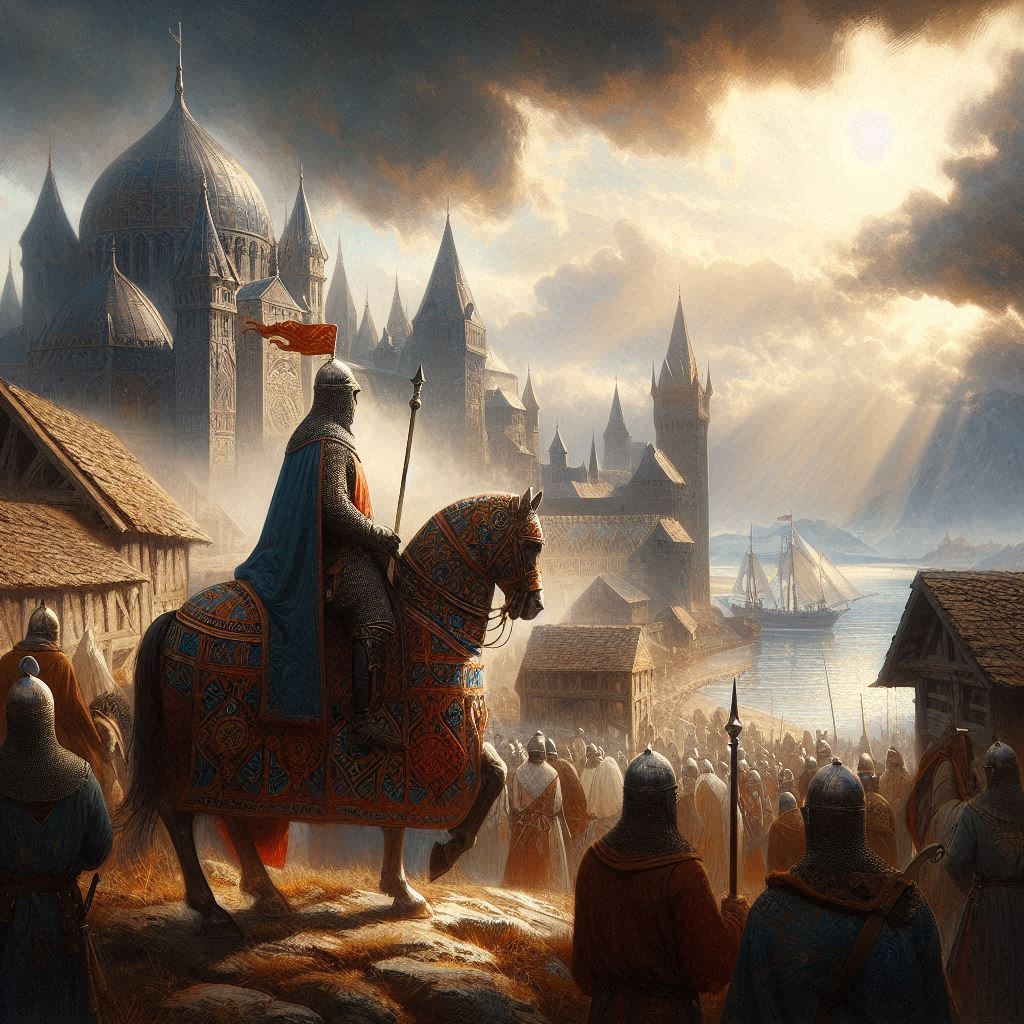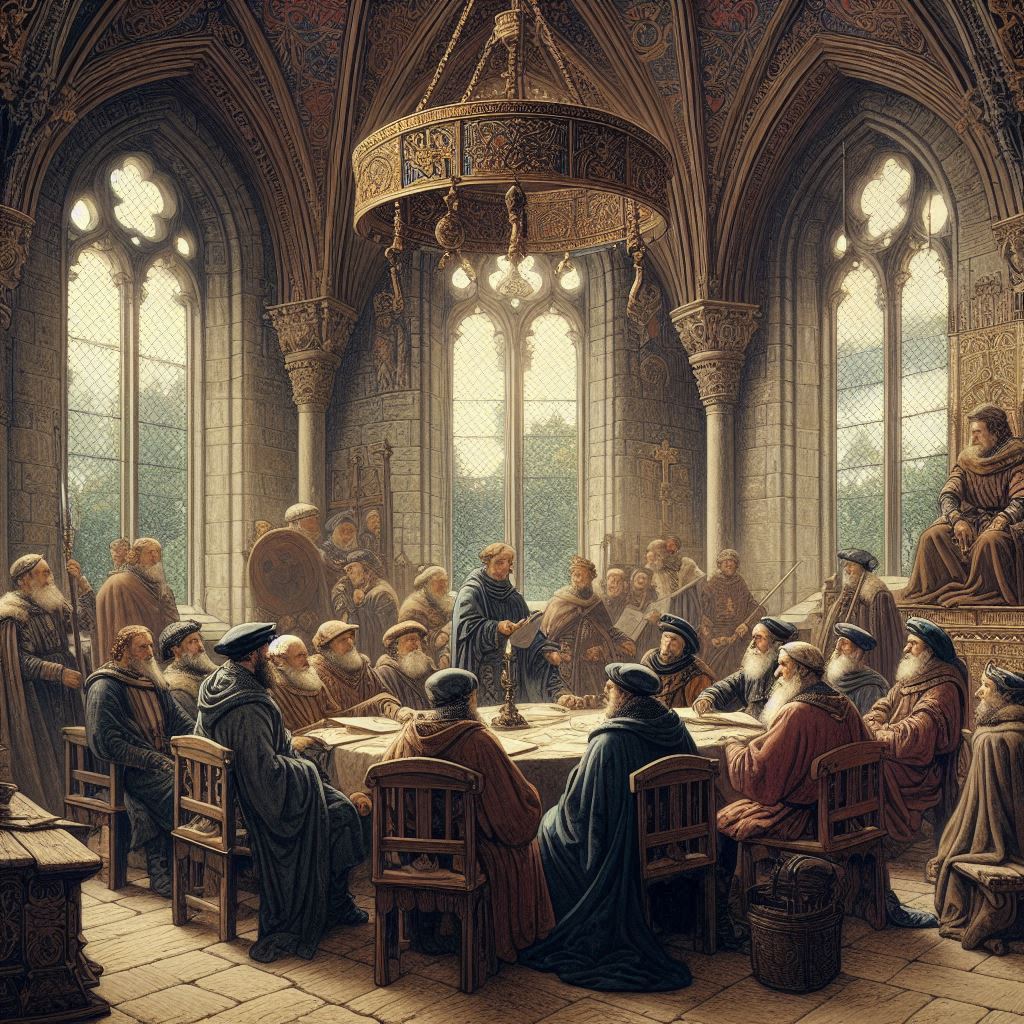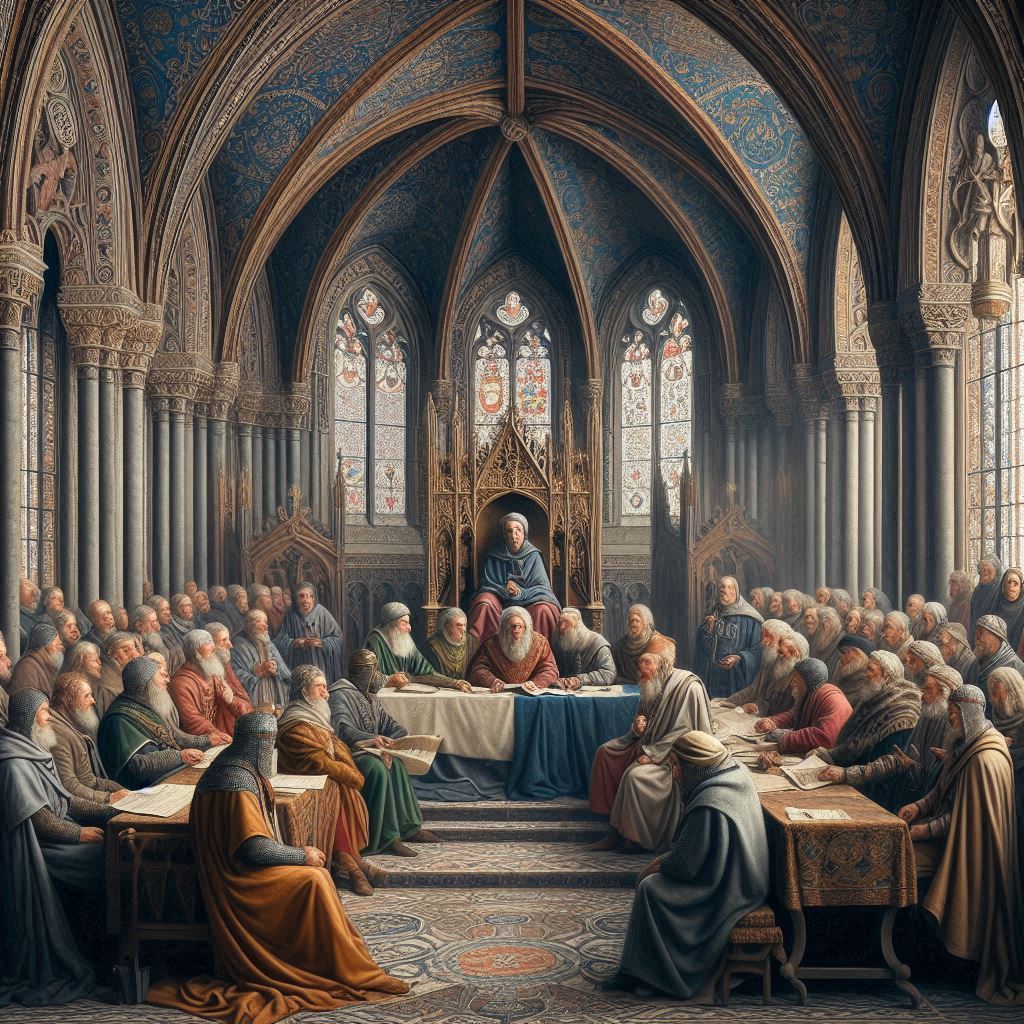Nobility culture
CULTURES SKILLS
- Administration
- Advertising
- Appraisal
- Athletic Games
- Bribery
- Diplomacy
- Fauna Lore
- Flora Lore
- Heraldry
- Interrogation
- Leadership
- Lie
- Man. in Chain
- Man. in Fur
- Man. in H. Leather
- Man. in Plate
- Man. in S. Leather
- Mapping
- Military Organization
- Propaganda
- Public Speaking
- Region Lore
- Riding
- Riposte
- Seduction
- Strategic Games
EXTRAS
Trained weapon skill
Extra languages
Additional Body Development
Legend
“Since the dawn of time, the races have chosen individuals to lead or have been forced to do so by the strong.”
Description

Nobility cultures are characterised by refinement, elegance, and a strong sense of hierarchy. They value education, art, and diplomacy, often living in opulent palaces and castles. Nobility are typically well educated and possess high intuition for political manoeuvring and social graces. They value empathy for maintaining relationships and public image. Their lifestyle doesn’t require high constitution or strength, but they benefit from access to quality healthcare, reflected in a higher recovery rate. Their upbringing exposes them to different cultures, granting them insight into foreign languages. Finally, their privileged lifestyle contributes to a higher health maximum.
Heraldry is central to nobility, emphasising family symbols, coats of arms, and sigils as means of displaying lineage, achievements, and affiliations. There is a vast and complex educational system for nobles, including training in diplomacy, governance, etiquette, and other skills required for leadership, often resulting in apprenticeships with experienced nobles:
- Classical Studies: intensive training in history, literature, and philosophy, with a focus on past rulers and great thinkers.
- Diplomacy and Etiquette: Extensive lessons in courtly manners, negotiation tactics, and the intricate dance of political discourse.
- Languages: Instruction in multiple languages, both of neighbouring realms and ancient tongues, to facilitate diplomacy and study of historical texts.
- Martial Arts: Basic combat training, often including swordsmanship and horseback riding, regardless of gender.
- Governance and Law: In-depth study of legal systems, economic principles, and statecraft.
- Heraldry and Lineage: Thorough education in family histories, alliances, and the complex web of noble relationships.
- Arts and Culture: Exposure to and practice of various arts, including music, poetry, and painting, to cultivate refinement and patronage skills.
- Magical Theory: While not all nobles practice magic, most receive basic education in magical principles and their applications in governance.
- Apprenticeships: Young nobles often serve as pages or ladies-in-waiting in other courts, gaining practical experience and forming alliances.
- Religious Studies: Education in the “True Gods” and the nobility’s divine right to rule, including rituals and ceremonies that reinforce their status.
This comprehensive education system ensures that nobles are well-prepared for their roles as leaders, diplomats, and patrons of culture, setting them apart from the common folk and reinforcing their elevated status in society. It also teaches them how to act in public and be in privacy.
Lifestyle: Nobles live within a formal political structure, residing in their palaces, castles, and fortresses, secluded from the common folk. They interact primarily with urban citizens and have exclusive access to education and knowledge, as well as a refined taste for luxury goods. Their role as administrators and rulers immerses them in a complex world of court politics, intrigue, alliances, rivalries, and power struggles within the noble class.
Diet: Nobility enjoys the most diverse and luxurious diets, with access to the finest meats, breads, fruits, and imported delicacies, it features meats from various animals, fresh fruits and vegetables from extensive gardens. Their food is often rich, heavy, and prepared with exotic spices, herbs, and delicacies imported from afar. Feasts are common, showcasing a variety of dishes flavoured with exotic spices, and food is a symbol of wealth and power, leading to a diet that is varied but sometimes indulgent to excess.
Traditions and Stories: Nobility is steeped in a system of honour and dueling. Disputes are settled through formal duels or codes of honour, emphasising personal integrity. Formal ceremonies and rituals, such as coronations, weddings, and grand feasts, showcase their status and traditions. They often have intricate stories and legends about their lineage, heroic ancestors, and the founding of their houses.
Marriage Pattern: Nobles form alliances through arranged marriages to consolidate power, secure territories, or strengthen their family’s influence. These alliances can lead to long-standing rivalries or close partnerships among noble houses.
Religion: Religion is often a personal matter, kept within the family or household. Nobles may follow subdued rituals or belong to organised cults and shrines, with a focus on the “True Gods.”
- Religious system: Syncretism: Blending of different religious beliefs and practices.
- God-Mortal Interaction: They believe that the ruling class derives their authority directly from the divine and have a carefully constructed belief system designed to reinforce the nobility’s power.
- Rituals: elaborate ceremonies to reinforce the divine status of the nobility, often involving lavish displays of wealth.
- Impact on Society: A rigid hierarchical structure with the nobility as intermediaries between the people and the divine. Religion is often used to justify social inequalities.
Skjald Vinotis
Craftsmanship: Noble cultures have a deep appreciation for the arts, including music, poetry, and painting. They are patrons of the arts, supporting painters, musicians, and scholars, using art and culture to enhance their reputation and preserve their family’s legacy. Nobles contribute to the development of law, literature, architecture, and other cultural aspects, often focussing on their own well-being and prestige.
Clothing and Decoration: Nobles wear fine woollen tunics, silk garments, and other luxurious materials. Their clothing is often adorned with intricate embroidery, gemstones, and heraldic symbols, reflecting their status. Jewellery and accessories made from precious metals and stones further signify their wealth and position.
Armour: Nobles have access to all types of armour, from finely crafted plate armour to decorative ceremonial pieces.
Weapons: Their weapons include swords, daggers, and other finely made arms, often with ornate designs.
Special Items: Nobility create and possess items made from wood, bark, fur, leather, and feathers, often with symbolic or decorative purposes. These items can also include rare artefacts and heirlooms passed down through generations, believed to possess magical or spiritual power.
Skjald Yell'a'Beard
Time: They are strictly scheduled and frequently chronicled, with seasons, courtly obligations, feasts, and diplomatic occasions as focal points.
Accomplishment and achievement: Personal glory, prestige, titles, achievements, expanding authority, political alliances, legacy, lineage preservation, and cultural patronage are all highly valued.
Authority Interacting: Interactions with kings, queens, and court advisers exercising authority are defined by complex hierarchies that include inherited authority, formal etiquette, rigid rules, and hierarchies, with an emphasis on lineage and decorum.
Fears and Inabilities: Nobles have no special fears or inabilities but hold certain superstitions and concerns about maintaining their status and power.
Mien: Culture has a low impact on demeanour, allowing for a wide range of individual expression. Nobles can be quiet, independent, reclusive, or gregarious and sociable.
Mannerism: Nobility does allow for individual development and expression while being influenced by societal expectations; thus, nobles can vary greatly in personality and ruling style, from benevolent to tyrannical.
Prejudices: Nobles generally look down on other subcultures, especially disliking Nomads.
Skjald Sejrik
General Resistance: Nobles have better overall health due to superior nutrition and living conditions.
Disease Resistance: Low, due to limited exposure to various disease sources, but they could be susceptible to diseases brought by travellers.
Poison Resistance: Low to Moderate. Their administrative roles might not grant them inherent poison resistance.
Remedies: Nobles have access to skilled physicians and advanced treatments, including rare herbs and potions.
Skjald Valgrif
History

Noble houses might trace their lineage back to legendary heroes or powerful magical beings, having long and complex histories filled with tales of alliances, rivalries, and dynastic struggles. The origins of their titles are often ancient, with stories of early leaders and subjects from eras long past. The nobles span a range of titles, with the highest rank ever being the High King, following the establishment of the High King’s realm. A realm that was one of the two largest challenges to noble power in recent times, the other being the great invasion, as both impacted heavily on nobility alliances and rivalries.
When the 1st alliance came touring in 1170, many nobles saw it as a tool to tip old balanced stalemates and win land, resources, and fame. It was but a few who realised how big a threat it could become, and even those split in two factions. Those who thought it would crumble and slide into the stream as nobles do best, and those who opposed it and joined the torch. On a tsunami of promises of freedom, laws, and justice of all, it was not hard to figure out who would gain the support of the people and thus win. Thus, the realm ended up a reality, and the high king brought peace, laws, and justice—and corruption in the gargantuan court at Grimsborg and throughout the vast empire.
However, the great invasion of 1277 constituted the most serious danger to nobles in recent history, bringing nothing but servitude and death to all Indigenous, wanderers, and n-erectus. Of course, some nobles tried to take advantage of it as they had with the 1st alliance and the realm. But the traitors quickly joined the 2nd alliance, hoping for a royal pardon in return for the slavery the invaders instilled, or being thrown into boiling cauldrons and saved as food. Because the Pigryn, Ye’Til, and the rest of the invaders were unspeakably brutal. Eventually successful, some nobles were pardoned by the hing king while others were punished according to their actions.
So now the biggest threats are the lack of nobles in certain areas, leaving people at the hands of uprising warlords, brigands, gangs, and agents of neighbouring nobility. The situation with the razed lands, ruined and plundered storages, and general tumult also sets the scene for peasant uprisings for nobles to loose the grip.
Skjald Sejrik
I need to stress that if people think the great invasion and the threat from outlands were serious, it is nothing compared to what the contender gods are plotting in their internal struggle—because to them we are but pawns of mana. To be manipulated and consumed as they see fit. Sadly, many nobles are unable to cope with this fact, despite all their education and wisdom.
Skjald Yell’a’Beard
Cartography

Nobles manage vast estates, including castles, grand palaces, and country estates. They oversee agricultural production, trade, and the well-being of the common folk within their domains.
Skjald Kazumix
Organisation

Nobility cultures are highly structured, with a rigid social hierarchy. Kings, queens, and emperors hold ultimate power, while lesser nobles vie for influence and prestige. Court etiquette and diplomacy are paramount, with different noble families constantly seeking to expand their power and secure their succession.
- High king / High queen
- Emperor/emperess
- King / Queen
- Crown prince / Crown princess
- Archduke / Archduchess
- Grand prince / Grand princess
- Grand duke / Grand duchess
- Prince / Princess
- Duke / Duchess
- Fürst / Fürstin
- Marquis / Marchioness
- Count / Countess
- Viscount / Viscountess
- Baron / Baroness
- Knight / Lady
- Esquire
Skjald El Mary
Court Politics and Intrigue:
In the wake of the Great Invasion and the disappearance of the Realm, court politics and intrigue have become even more complex and vital. While specifics vary widely across regions and races, some common threads emerge:
- Power Vacuums: With established hierarchies disrupted, many nobles vie to fill power gaps, leading to increased political maneuvering.
- Shifting Alliances: Unstable times have led to rapidly changing allegiances as nobles seek to secure their positions.
- Information as Currency: Knowledge of divine interactions, invasion aftermath, or of former traitors can be leveraged for significant political gain.
- Multiracial Diplomacy: Interactions between noble courts of different races have intensified, adding layers of cultural complexity to political dealings.
- Survival Politics: Some courts focus on mere survival and reconstruction, while others already plot expansionist moves.
- Divine Influence: The reality of divine intervention adds a unique dimension to court intrigue, with some nobles seeking divine favor or guidance.
- Adaptive Governance: Nobles who can adapt their ruling styles to the post-invasion world often gain advantages over more rigid traditionalists.
Skjald Ulrich
Not all noble interaction is with nobles; sometimes it breaks boundaries and crosses into other cultures, so to speak, or spans across social classes. It in fact all depends on what it is the noble needs or thinks the contacted people can be used for or do.
- Formal Audiences: Nobles might grant formal audiences to adventurers who have gained renown or completed important quests. These interactions would be highly structured, with strict protocols and etiquette.
- Patronage: Some nobles might act as patrons to adventuring parties, providing resources and protection in exchange for services or a share of discovered treasures.
- Covert Meetings: Nobles seeking to maintain plausible deniability might arrange secret meetings with adventurers for sensitive missions.
- Social Events: Adventurers of significant reputation might be invited to noble gatherings as curiosities or entertainment, allowing for less formal interactions.
- Advisors and Specialists: Nobles might consult non-noble experts (e.g., master wizards, renowned scholars) on specific matters, treating them with respect but not as equals.
- Intermediaries: Most interactions might occur through noble-appointed intermediaries rather than direct contact with high-ranking nobles.
- Crisis Situations: During emergencies (e.g., monster attacks, wars), nobles might interact more directly with capable non-nobles out of necessity.
- Cultural Exchange: Nobles interested in foreign cultures might engage more openly with well-traveled adventurers.
- Suspicion and Caution: Many nobles might view adventurers with a mix of fascination and wariness, aware of their potential usefulness but also their unpredictability.
- Power Dynamics: Interactions would always be colored by the power imbalance, with nobles expecting deference even when seeking help.
Skjald El Mary
Special

Noble cultures focus on maintaining or gaining power and securing their succession. They have a keen interest in heraldry, diplomacy, and the arts, using these to solidify their status and legacy.
Skjald Ulrich
Last Updated on 2024-10-20 by IoM-Christian
